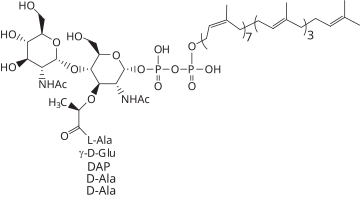Lipid II

| |
| Names | |
|---|---|
| Systematic IUPAC name
(2R,5R,8S,13R,16S,19R)-19-{[(2R,3R,4R,5S,6R)-3-Acetamido-5-{[(2S,3R,4R,5S,6R)-3-acetamido-4,5-dihydroxy-6-(hydroxymethyl)oxan-2-yl]oxy}-2-[(1,3-dihydroxy-1,3-dioxo-3-{[(2Z,6Z,10Z,14Z,18Z,22Z,26Z,30Z,34E,38E,42E)-3,7,11,15,19,23,27,31,35,39,43-undecamethyltetratetraconta-2,6,10,14,18,22,26,30,34,38,42-undecaen-1-yl]oxy}-1λ5,3λ5-diphosphoxan-1-yl)oxy]-6-(hydroxymethyl)oxan-4-yl]oxy}-8-(4-aminobutyl)-13-carboxy-2,5,16-trimethyl-4,7,10,15,18-pentaoxo-3,6,9,14,17-pentaazaicosan-1-oic acid | |
| Identifiers | |
3D model (
JSmol ) |
|
| 9039417 | |
| ChEBI | |
| ChemSpider | |
| KEGG | |
PubChem CID
|
|
| |
| |
| Properties | |
| C94H156N8O26P2 | |
| Molar mass | 1876.23 g·mol−1 |
Except where otherwise noted, data are given for materials in their standard state (at 25 °C [77 °F], 100 kPa).
| |
Lipid II is a precursor molecule in the synthesis of the
A number of analogous compounds are produced via a similar pathway in some bacteria, giving rise to cell wall modifications. See
Synthesis
In peptidoglycan biosynthetic pathway
Lipid II is the final intermediate in
The essential MurJ
Artificial production
A method for artificial production of lipid II has been described. For synthesis of lipid II from UDP-MurNAc pentapeptide and undecaprenol, the enzymes MraY, MurG, and undecaprenol kinase can be used.[5] Synthetic Lipid II analogues are used in experiments studying how it interacts with and binds molecules.[6] Significant quantities of the important peptidoglycan precursor have also be isolated, following accumulation in bacterial cells.[7]
Functions
Polymers of lipid II form a linear glycan chain. This reaction is catalyzed by the glycosyltransferases of family 51 (GT51). Transpeptidases cross link the chains and form a net-like peptidoglycan macromolecule. The resulting glycopeptide is an essential part of the envelope of many bacteria. Lipid II was estimated to exist at a concentration of less than 2000 molecules per bacterial cell.[8]
Lipid II biosynthesis is functional and essential even in organisms without a cell wall like
In the discovery and mechanism of assembly of pili in gram positive bacteria Lipid II has been implicated as a crucial structural molecule. It anchors the pili during or after polymerization of the pilus components.[10]
Antibiotics
Since Lipid II must be flipped outside the cytoplasmic membrane before incorporation of its disaccharide-peptide unit into peptidoglycan, it is a relatively accessible target for antibiotics. These antibiotics fight bacteria by either directly inhibiting the peptidoglycan synthesis, or by binding to lipid II to form destructive pores in the cytoplasmic membrane.[11] Examples of antibiotics that target Lipid II include:
- Vancomycin and its synthetic derivatives[11]
- Ramoplanin[11]
- Several lantibiotics, including the common food preservative nisin[12]
- Teixobactin[13]
- Copsin
- Human alpha defensins
Binding
The D-Ala-D-Ala terminus is used by glycopeptide antibiotic vancomycin to inhibit lipid I- and lipid II-consuming peptidoglycan synthesis; in vancomycin-resistant strains vancomycin cannot bind, because a crucial hydrogen bond is lost. Oritavancin also uses the D-Ala-D-Ala terminus, but in addition it uses the crossbridge and D-iso-glutamine in position 2 of the lipid II stem peptide, as present in a number of Gram-positive pathogens, like staphylococci and enterococci. The increased binding of oritavancin through amidation of lipid II can compensate for the loss of a crucial hydrogen bond in vancomycin-resistant strains,[14]
Lantibiotics recognize lipid-II by its pyrophosphate.[2]
Lipid II interacts with human
References
- ^ "MetaCyc EC 2.4.1.227". biocyc.org.
- ^ PMID 23588060.
- PMID 25013077.
- ^ "TCDB 2.A.66.4.3". tcdb.org.
- PMID 24990652.
- PMID 26653142.
- PMID 28553948.
- PMID 1592809.
- PMID 19656295.
- ^ Pili in Gram-positive pathogens, Nature, vol 4, pg 513
- ^ PMID 18063720.
- PMID 19008088.
- S2CID 4464402.
- PMID 25403671.
- PMID 24244161.
- PMID 25291014.
External links
- Lipid+II at the U.S. National Library of Medicine Medical Subject Headings (MeSH)
